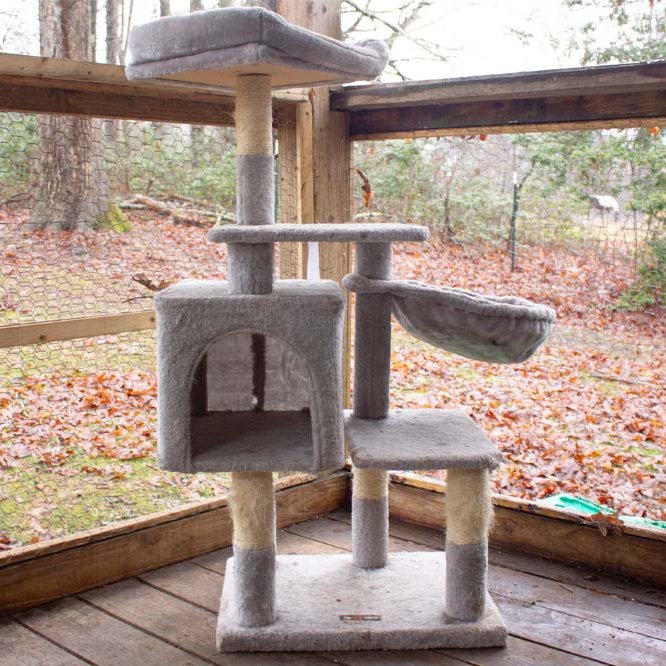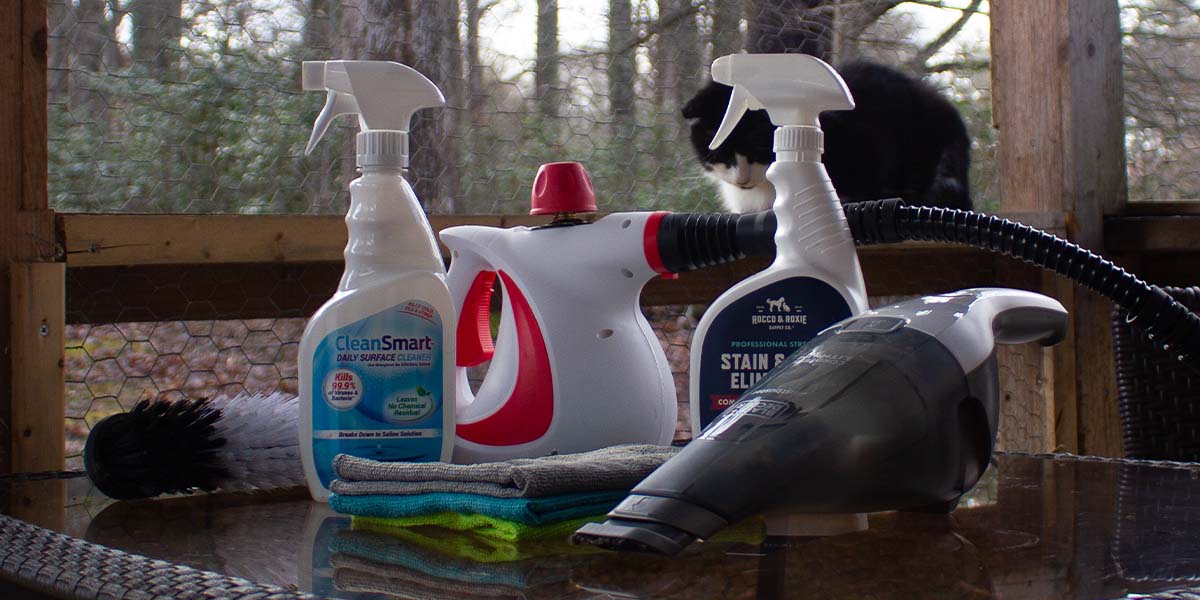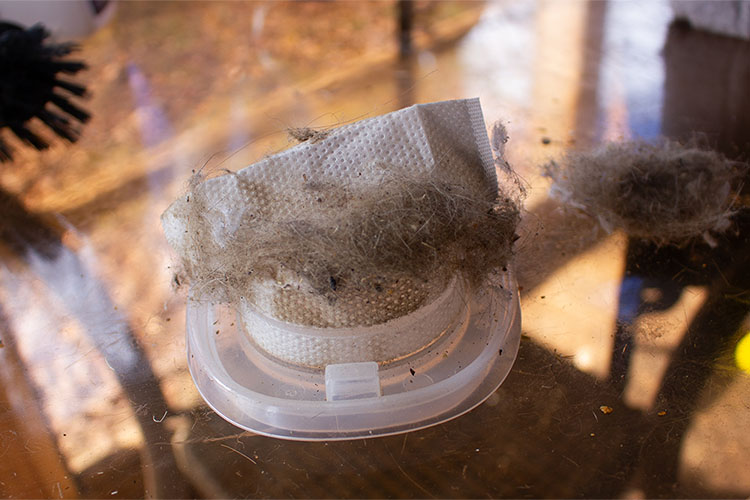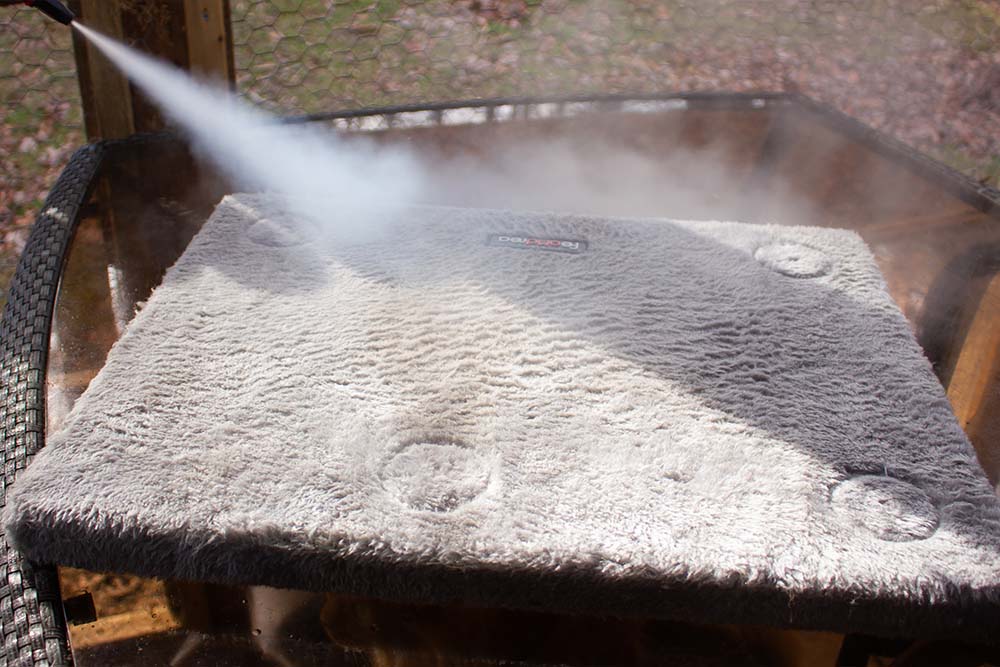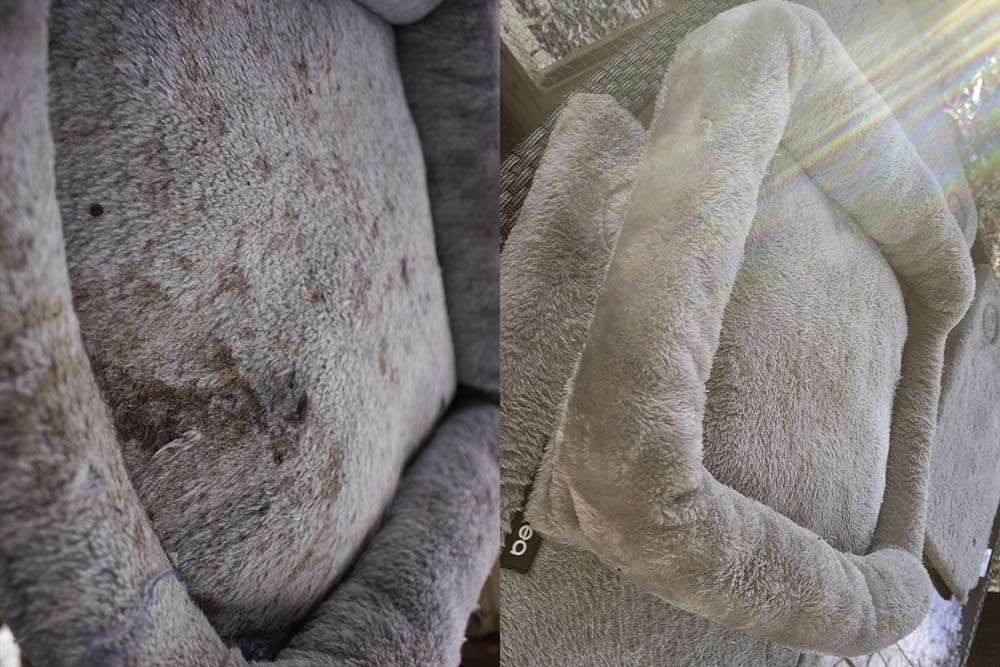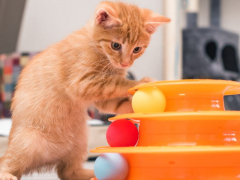Shannon Perry / Cats.com
There’s no denying that having a cat tree in your home is a good idea. From satisfying their instincts to curbing bad behavior, this piece of furniture is essential to your cat’s well-being. Cats do everything from sleep to get rid of hairballs in their cat tree. This means that it’s pretty much a magnet for dirt, germs, and stains.
As a mom of 11 cats—yes, you read that correctly—I’ve come to accept that my home (and paycheck) belongs to them. So, I gladly accepted when a friend offered a free but well-loved Feandrea cat tree. Here’s a step-by-step guide on how to clean a cat tree.
Supplies You’ll Need
Shannon Perry / Cats.com
Before you begin, you should gather the right tools and cat-safe cleaning supplies. According to Cornell University, cats spend 30 to 50% of their day grooming. Cleaning products that contain toxic and harmful chemicals can transfer onto your cat’s coat and be ingested as they groom. Here are the must-haves for cleaning a cat tree:
- Rocco & Roxie Supply Co. Enzyme Cleaner: Enzymatic cleaners break down particles that cause odor and stains. Removing the odor after your cat has had an accident can help minimize the chances of it happening again.
- Microfiber Cleaning Cloth: Great for maintaining cat trees between deep cleans, microfiber cleaning cloths work best when you spritz a little water on the carpeted platforms, then use the rough side to wipe it down.
- BLACK+DECKER Cordless Handheld Vacuum: After reading numerous reviews, I got this cordless vacuum specifically for this task. Users commented on its effectiveness, ease of use, and easy charging. One reviewer even has one with each cat box in her home.
- CleanSmart Daily Surface Cleaner: I like that this surface cleaner doesn’t leave behind a chemical residue. Once your cat tower has dried, there’s no chance they’ll get potentially dangerous chemicals on their coat.
- Hex Key: You’ll also need a hex key (hexagon wrench) to unscrew the bolts that hold the cat tree together. Your cat tree likely came with one, but you can buy them online, at your local hardware store, and even at some dollar stores.
The following items are optional but recommended. These are things that I ended up using (or wish I had on hand) while I cleaned my cat tree.
- Gloves. I forgot to use gloves while cleaning, so my hands got pretty dry due to the cleaning products. Be sure to use latex, latex-free, or rubber gloves when cleaning your cat tree.
- Scrub Brush. I didn’t think I’d need one, but a scrub brush was handy for scrubbing more stubborn stains. Although, I’m not sure that that’s good for the carpet long-term
- Decdeal Steam Cleaner: While optional, a steam cleaner can help break up and lift stains before, during, and after you apply cleaners. You use less product and put less liquid on your cat tree. Plus, it disinfects.
Before You Get Started
Before you dive into cleaning, here are a few tips:
- Take a picture: Most cat trees have multiple platforms and sisals, and the first step of cleaning will be to take your cat tree apart. Remembering what goes where can be tricky, but a picture is a good guide when reassembling your cat tree.
- Label each part: You could also label each part with a permanent marker and masking tape. Label the order it goes in from the bottom or another easy-to-remember method. You may need to replace the tape as you clean.
- Find a well-ventilated area: While the cleaners and sprays used for cleaning a cat tree aren’t harmful, they can become overwhelming in an enclosed place. Consider bringing the tree outside. Sunlight can also help kill germs.
- Plan ahead: Most cat trees will take more than an hour to clean. Between letting cleaners sit to break up stains and letting the cat tree dry, it might be an all-day endeavor. Plan other things to do between tasks or let the cat tree dry overnight. (I spread mine out over two days.)
6 Steps to Cleaning Your Cat Tree
When we think of cleaning a cat tree, it’s vacuuming and maybe spraying an air freshener, then calling it a day. While vacuuming is better than nothing, a deep clean with the right tools and cleaners can make a big difference for the health of your cats, your household, and the longevity of your cat furniture.
1. Take the Cat Tree Apart
Store-bought cat trees, even ones that come assembled, can typically be disassembled. While it’s extra work, this is an important step. By taking apart your cat tree, you can make sure there isn’t damage that could compromise its integrity — such as cracked perches or weak poles — and it makes cleaning easier.
Also Read: How To Get A Cat To Use A Cat Tree In 6 Simple Steps
Taking it apart is also an excellent opportunity for repairs. Cat towers with scratching posts (sisal posts) often need new rope or a sisal replacement. With sisals made of PVC piping or wood, you can purchase a ball of sisal rope and use hot glue to attach it. For sisals made of cardboard, replacing the pole is typically better. Measure your pole to find the correct replacement. Or, for cat condos with multiple sizes, invest in a multi-pack. You’ll likely need them later anyway.
2. Vaccum Every Inch
Even after picking off fur and using a microfiber cloth, the vacuum still picked up a lot of stray hair. Shannon Perry / Cats.com
Once you’ve taken your cat tree apart, it’s time to remove dust, hair, and debris. I discovered it was easier to vacuum the pieces after I used a clean microfiber cloth, so consider wiping down each platform before vacuuming. Once vacuuming, I found the brush attachment with the dustbuster to be invaluable; nothing could get in the nooks and crannies of the pillowed rim as well as this attachment.
If you don’t have a vacuum cleaner, use a lint roller or tape to get up as much loose cat hair as possible. Regardless of how you remove hair and debris, it’s also a good opportunity to watch for parasites, like fleas, and any evidence of other issues.
3. Steam Clean Your Cat Tower
Steam cleaning is a good first step in applying cleaner to a cat tree. It can be used repeatedly to break up stubborn stains. Shannon Perry / Cats.com
Steam cleaning is optional but it may help if you have hard-to-lift stains. Some guides recommend this step after you’ve used a spray cleaner, but it went better when I tried the steamer first. And it’s better when it comes to the longevity of your cat condo.
The platforms on many cat trees are particle board. Particle board is made by gluing wood shavings and particles together. It isn’t water resistant and water exposure can damage it. A steam cleaner uses more heat and vapor than water, so using that first may result in less liquids seeping through the carpet and to the particle board.
4. Use Enzymatic Cleaners and Disinfectant
Once the cat tree was clean, it looked almost brand new. There was a very slight discoloration on the pillowed perch. Heavier stains were gone. Shannon Perry / Cats.com
Here’s an interesting fact: both male and female cats can spray. Around 5% of female and 10% of male altered cats will still mark their territory even altered. While the smell may not be as pungent as a tom cat, it’s still there.
Enzymatic cleaners work as odor removers by breaking down the particles that cause odors and attract cats to remark that spot. For mostly clean cat trees, this is just a matter of spot-cleaning or misting everything to maintain cleanliness. My cat tree was heavily stained, so I did a few applications of Rocco & Roxie’s enzymatic cleaner. I also used the steam cleaner in between. After repeatedly applying the cleaner, waiting, then scrubbing and soaking up the residue with clean cloths and paper towels, almost all the stains on my cat tree were gone.
As a last touch for cleaning, I sprayed CleanSmart to ensure the cat tree was free of anything that could hurt my cats, like ringworm spores.
You may want to spot-test your cat tree before applying any kind of cleaner. Some fabrics may be less tolerable than others and require alternative cleaning methods, like baking soda and vinegar.
5. Let the Cat Tree Air Dry
Once you’re satisfied that your cat tree is clean, you should allow it to dry completely so that the cleaners dissipate and your cat tree can air out. You can help speed this along by setting the parts out in the sun. It took my cat tree about two hours to dry and a bit longer for the pillowed platform.
6. Reassemble Cat Tree
When reassembling your cat tree, pay special attention to its stability and ensure all bolts and connections are tight. Here are a few tips that may make reassembly easier:
- Work from the bottom up: By working bottom to top, you can test the stability of the cat tree by giving it a good shake with each platform addition. Building it this way also means less work and heavy lifting
- Do certain sections separately: With my cat tree, the box part is two platforms, cloth walls, and four carpeted poles. It was easier for me to assemble the box first and then add it as a unit.
- Pay attention to double-sided bolts: For some cat trees, double-sided bolts are used to connect two sisals. It’s much easier to screw the bolt into the bottom sisal first, then the top. In some cases, a platform goes between the sisals.
- Spray with Feliway: Cats don’t do well with change. While they may be familiar with their cat tower, new smells (or the lack of old ones) might make them reluctant to explore it again. Feliway may help your cat get comfortable again with the cat tower.
How To Maintain Your Cat Tree
Generally speaking, you should deep clean your cat tree about once a month. Regular cleaning can make it easier and faster to deep-clean your cat tree. Here’s how you can save yourself a lot of work.
- Once a day: Check for accidents or odors and spot treat immediately. Spot treatment prevents stains and odors from setting in.
- A few times a week: Spray the cat tower with a disinfectant that’s safe for cats, like CleanSmart. Infection-causing viruses and bacteria can live on your cat tower and be transferred from cat to cat or from your cats to you.
- Once a week: Mist the cat condo with water and use the rough side of a microfiber cloth to remove your cat’s fur. Doing this helps prevent hair from getting embedded in the carpet.
Frequently Asked Questions
How often should you clean a cat tree?
You should deep clean your cat tree about once a month. Maintaining your cat tree in between deep-cleaning can reduce the amount of work or help you extend that window beyond four weeks. To do this, you should spot clean accidents immediately and routinely remove hair and dirt with a vacuum or microfiber cloth.
How do you get the smell out of a cat tree?
The best way to get smells out of a cat tree is with an enzymatic cleaner. Designed to neutralize the particles that cause foul odors, these cleaners often remove stains and sanitize. Enzymatic cleaners are excellent for cleaning up pet messes on surfaces like couches, cat towers, and carpets.
When should you replace cat trees?
A well-made and maintained cat tree can last several years. When cat parents are no longer comfortable with the costs and time-consuming repairs, buying a new cat tree might be best.
Is it safe to use a used cat tree?
Yes! It’s perfectly fine to bring a used cat tree into your home. However, it’s important to deep clean and sterilize it first. You should also check it for any weak points or instabilities that might endanger your cat.
What are pet-friendly cleaning products?
Rocco and & Roxie Enzyme Cleaner and CleanSmart Surface Cleaner are examples of two pet-safe, effective cleaning solutions you can use around the home. Dawn dish soap is another safe cleaning product to wash and clean pet food bowls and other hard, non-porous items around the house.
